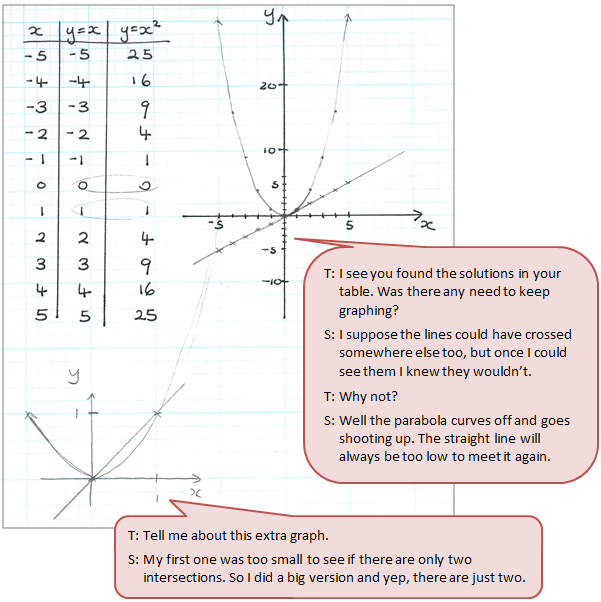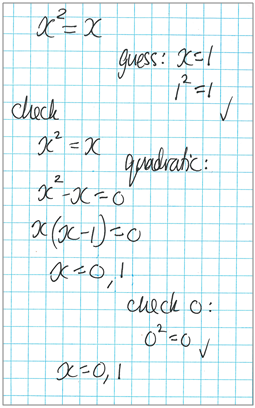The purpose of this activity is to engage students in using algebraic equations, graphs and/or tables to solve a problem.
This activity assumes the students have experience in the following areas:
- Forming linear and quadratic equations.
- Factorising and expanding quadratic expressions.
- Solving linear and quadratic equations.
- Graphing linear and non-linear functions, and looking for intersections.
The problem is sufficiently open ended to allow the students freedom of choice in their approach. It may be scaffolded with guidance that leads to a solution, and/or the students might be given the opportunity to solve the problem independently.
The example responses at the end of the resource give an indication of the kind of response to expect from students who approach the problem in particular ways.
Task: Are there any values for x such that: x2 = x ?
Extension: What about xn = x (where n is any whole number)?
The following prompts illustrate how this activity can be structured around the phases of the Mathematics Investigation Cycle.
Make sense
Introduce the problem. Allow students time to read it and discuss in pairs or small groups.
- Do I understand the situation and the words? (Students may need support to understand the meaning of algebraic terms, especially xn.)
- What numbers should I try first to see if I can find equalities? Why start with those numbers?
- What mathematics is likely to be useful?
- How will I approach the problem in a systematic way?
- What will my solution look like? (Values for x and n that satisfy the equation condition.)
Plan approach
Discuss ideas about how to solve the problem. Emphasise that, in the planning phase, you want students to say how they would solve the problem, not to actually solve it.
- Have I shown my workings in a step-by-step way?
- What tools and ways of recording will be useful?
- Do I expect to see a pattern? Why?
- How many examples should I try before I stop working and look for patterns? Which examples will be best?
- How could I show this problem using numbers, equations, pictures, graphs, tables, or materials?
- What strategies can I use to get started?
- What tools (digital or physical) could help my investigation?
Take action
Allow students time to work through their strategy and find a solution to the problem.
- Have I shown my workings in a systematic way?
- Do my answers seem correct? Have I checked them?
- Are there any patterns that might be generalised?
- What is the same and what is different about all the examples?
- Can I explain why this happens?
- Are there other possible answers or ways to solve the problem?
- Have I used algebra to express the generalisations?
- Can I use algebra to prove what I have found?
Convince yourself and others
Allow students time to check their answers and then either have them pair share with other groups or ask for volunteers to share their solution with the class.
- What is the solution?
- Is my working clear for someone else to follow?
- How would I convince someone else I am correct?
- Could I have solved the problem in a more efficient way?
- Have I tested my generalisation out on other cases (e.g., Values for X and n)
- How can I clearly show what I found out?
- Which representation (text, table, graph, numbers, diagram, equations) will be useful in reporting my findings?
- Which ideas would convince others that my findings answer the investigation question?
Examples of work
Work sample 1
The student finds a solution to the equation in the intersection of the two relationships, y=x and y=x2.
Click on the image to enlarge it. Click again to close.
Work sample 2
The student solves a quadratic to find all the solutions possible.
Click on the image to enlarge it. Click again to close.
Work sample 3
The student generalises to find all the solutions for y=xn.


